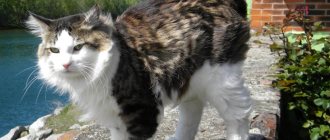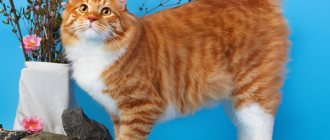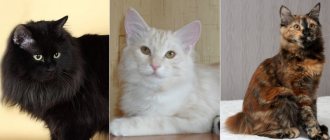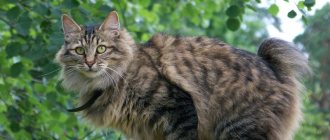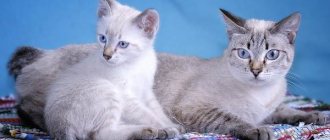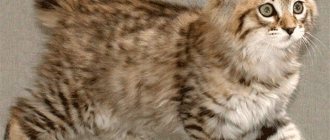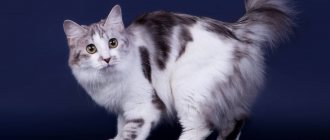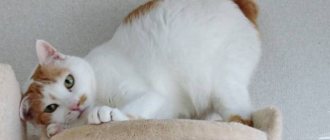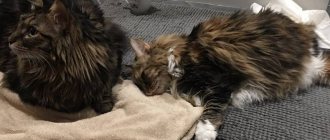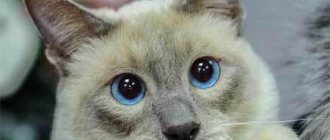According to official statistics, a broken cat's tail is one of the most common injuries. Since this part of the animal’s body performs important coordination functions, damage to it brings pain and discomfort to the pet, and can also cause complications. To prevent serious consequences, as soon as the cat’s tail is pinched, it is better to take the mustachioed cat to a veterinary clinic, where he will receive qualified help.
If a cat's tail is stepped on and it breaks, you cannot do any manipulations, namely, straighten or stretch the vertebrae. This will only harm the animal.
Mekong Bobtail: history of the breed
Based on their origin, animals of this breed can be considered one of the most ancient representatives of the cat world. A museum in Thailand houses a 14th-century manuscript depicting a Mekong bobtail cat lying next to a royal person. Animals were constant companions of the princesses of Ancient Siam. It was customary to trust these cute cats with their jewelry, which girls put on the pet’s curved tail.
Another legend explains the origin of the Mekong Bobtail's unique tail by its special role. In ancient temples, cats were trusted to guard ancient vases. Animals, as the legend says, lay down near the vases, wrapped their tails around them and did not allow anyone to touch them. That’s why their tail is bent and their eyes are slightly slanted.
Mekong Bobtails have skin that does not fit tightly to the body. This fact is also explained by the legend. The cats who protected the temple vases had to fight with poisonous snakes that encroached on the shrines. When bitten on the skin, the poison did not have time to quickly penetrate the blood, which sometimes saved the cat’s life.
This is interesting! The animal got its name from the Mekong River, which flows through the Indochina Peninsula through Vietnam, Laos, Burma, Cambodia, China and Thailand.
Cats were treated with great respect: they lived only in temples and with high-ranking persons.
Ordinary people were not allowed to have these animals. They were not allowed to take Mekong Bobtails out of the country - the punishment was very severe. Animals could only be given to respected people as a sign of respect and gratitude. It was precisely these expensive gifts that the governess who served with the king’s children and the British Ambassador Owen Gould received in the mid-19th century. The donated kittens became the ancestors of the Mekong Bobtail in Europe and America. Initially, breeders did not consider the main feature of the Mekong Bobtail - a curved tail with kinks - to be a distinctive sign of the breed. On the contrary, during selective selection, kittens that had fewer creases were valued more, and true bobtails were considered rejected Siamese.
For a long time, the animals were called Thai bobtails, and only in the mid-90s of the 20th century were the standards of the breed approved, which received its modern name - the Mekong bobtail - only in 2003. Since that time, the breed has gained its official status in the World Cat Federation (WCF).
Kurilian Bobtail
Kurilian Bobtail breed history: The Kurilian Bobtail is a Russian aboriginal cat breed.
It is believed that the Kurilian Bobtail was born as a result of a natural crossing of Siberian cats and Japanese Bobtails, brought to the Kuril Islands from neighboring Japan. The breed received official recognition in 1995.
Kurilian Bobtail Character: Kuril Bobtails are very smart, friendly, extremely talkative, curious beyond measure and devoted to their owners, like dogs.
The Kurilian Bobtail has short-haired and semi-longhaired variations.
Our site is also the site of a Kuril Bobtail breeder, so we have additional information about this breed:
more about Kurilian Bobtails
Kurilian Bobtail breed standard
buy Kurilian Bobtail
information about our Kurilian Bobtail
Mekong Bobtail: breed description, standards
In appearance and color, Mekong Bobtails are very similar to Siamese cats. The main distinguishing feature is the short, curved tail (Siamese have a long tail).
The World Cat Federation has approved the following standards for the Mekong Bobtail breed:
- a body with developed muscles, but elegant and slender, rectangular in shape;
- the paws are of medium length, strong, the claws are collected into a hard oval-shaped pad, but on the hind legs the claws do not retract completely;
- the head is wedge-shaped, the chin is strong, developed, the upper part of the head is flat, the line from the forehead to the tip of the nose is straight;
- ears, set high, slightly laid back, wider at the base than at the top, rounded at the tips, without tufts at the ends;
- the eyes are large, slightly slanted, the color is bright blue, blue or blue-blue;
- eyelids: upper – almond-shaped, lower rounded;
- the tail is short, usually consisting of three vertebrae, the standard length is a quarter of the cat’s body, curved (the first bend should begin at the base);
Important! Each Mekong Bobtail's tail is unique. This is a distinctive sign of the animal, because identical tails, with repeated bends and creases, according to felinologists, do not exist.
- the weight of an adult animal is up to 5 kg (cats are smaller than cats);
- the skin does not fit tightly to the body;
- the coat is smooth, practically without undercoat, color point color: paws, muzzle, ears and tail are dark in color.
Important! Defects of the breed are considered to be round eyes, lack of slanting, thick undercoat, and strongly pronounced cheekbones.
Mekong Bobtails are known for their longevity and good health. There have been cases where animals of this breed lived up to 24 years. They become sexually mature quite early and can bear offspring until old age.
Causes: what causes the injury?
Veterinarians identify the main factors that can cause damage:
- fight with other animals;
- dog bites;
- collision with a car, bicycle, etc.;
- strong squeezing by a door or foot;
- unsuccessful kitten games when the tail is pressed or stepped on;
- falling from height;
- cruel treatment.
A congestion is usually a congenital pathology in an animal.
The reason why a kitten's tail breaks is an unsuccessful delivery, for example, when the owner or the cat itself damaged an organ during the birth of the baby. Crooked tails can be the result of a genetic disorder called kink. Then the tail part is removed to the base. A docked ponytail looks like a plug. If you do not touch such an organ, it will be permanently lowered. It is impossible to straighten or straighten the crease - this will only harm the cat.
Mekong Bobtail: colors with photos
Mekong Bobtails come in a variety of colors. Today, breed standards recognize six color options:
- Seal-point;
- Red-point;
- Tortie-point;
- Blue-point;
- Chocolite-point;
- Tabby-point.
Interesting! All newborn kittens are white or soft cream in color, and only after a day their faces, paws, tail and ears begin to darken. Mekong bobtails acquire their true color only when they reach sexual maturity.
The most common is the Seal-point color, in which the animal’s body is the color of baked milk, and the limbs, tail, ears and muzzle are dark brown, almost black.
The rarest color is Red-point. The body of such Mekongs is white or pale peach, and the points range from rich peach to bright red. Males of this color are distinguished by their large size compared to their relatives.
Only female cats can have the Tortie-point color; males do not have it genetically. This coloring is usually called “tortoiseshell”. Dark points have a variegated color that smoothly transitions into a lighter body. Tortie-point mekongs are believed to bring happiness to the home.
Blue-point is also considered rare. The body of the animal is light silver or soft cream, and the points are silver-bluish, bluish-pink. Felinologists claim that along with their color, such Mekongs acquire softness of character and tenderness.
The color of Chocolite-point is emphatically contrasting: the body of the animal is white or soft cream, and the points are the color of dark chocolate. In this case, the cat's eyes may have a slight lilac tint. The birth of kittens of this color occurs extremely rarely, so they are especially valuable.
Tabby-point Mekongs are rare. A patterned pattern appears on the light body, which intensifies, as if appearing on the points. A distinctive feature is the letter “M” on the cat’s forehead.
Interesting! A biblical parable says that the letter “M” was written on the cat’s head by the Virgin Mary as a sign of gratitude to the animal that calmed the crying little Jesus. So all the descendants of that cat bear the divine sign on their foreheads.
In recent years, breeders have been trying to develop Mekong Bobtail cats in new colors:
- Cream-point;
- Lilak-point;
- variations Tabby, Tortie, Chocolite.
An interesting direction of selection is the creation of a golden shade of wool.
The Mekong Bobtail attracts breeders with its diversity. Photos, descriptions of the breed and various colors of these animals can be found in the best nurseries in our country and the world.
Why is the tail “broken”
Kittens with tail deformities can appear in litters of both outbred and purebred cats. Instead of a straight tail, the owners see tails bent to the side, broken in several places, or hooked. Regardless of the type of deformity, such a deviation permanently prohibits access to breeding and exhibitions. A fluffy kitten can become an excellent pet that retains all the characteristics of the breed, but the animal forever falls into the “home only” category.
Slight miscorrection of the tail, which is expressed in the last and penultimate vertebrae, is acceptable in some breeds, but breeding animals in such a situation is not recommended.
Veterinarians and breeders say that “unique” tails indicate the degeneration of the breed and are a serious genetic defect. When breeding such animals, you put all the offspring at risk, since the next generations may have not only a crooked tail, but also serious spinal disorders. Curvature of the spine is a direct path to congenital pathologies of internal organs, as a result of which the offspring will be non-viable.
The exact nature of such genetic abnormalities has not been established, but assumptions agree that closely related relationships are to blame.
Mekong Bobtail: character, habits
Many owners of Mekong Bobtails dote on their pets, and there are many reasons for this. By their nature, these animals have always lived among people, so they know how to tame their wild habits to please people.
Mekongs are very sociable and inquisitive: they will follow you around the house, carefully watching every step, and sometimes giving advice in their cat language.
Unlike many cats who prefer to remain mysteriously silent, Mekong Bobtails are the talkers of talkers. The timbre of their voice will help you accurately guess whether the pet is sharing good news, complaining, or talking about something sad. And if you keep up the conversation, it will become quite long.
Important! Mekong Bobtails are very sociable and do not tolerate loneliness. Try to pay more attention to your pet, be sure to talk to him.
Animals of this breed are caring parents, and they care not only for their kittens. If there are pets in the house, especially those that are smaller in size, Mekongs will try to lick them, will react to pranks and warn them against danger. The Mekong Bobtail is distinguished by this caring for others. Videos posted on the Internet show that these cats do not even touch guinea pigs, hamsters and rats.
Mekong Bobtails are selfless protectors: they can rush at a stranger who raises their voice at their beloved owner, and they will meow under the door, warning that someone is standing behind it. No dogs will be allowed near you on walks. By the way, when attacking or defending, the Mekong would rather bite its opponent than use its claws.
Cats of this breed are kind to children. They play with them with pleasure and allow themselves to be squeezed. If the pranks go too far, the Mekong will simply try to run away and hide.
Despite their natural kindness, cats of this breed are excellent hunters. They will watch their prey for a long time and patiently and will definitely catch it.
Treatment: first aid and correction of the situation
Bandaging the tail will be sufficient if there are no serious consequences after the injury.
Therapeutic measures are determined by the degree and extent of damage to the caudal vertebrae and the location of the wound. If only the tip of the tail hangs without violating the integrity of the skin, most likely, serious manipulations will not be required. The cat needs complete rest, proper nutrition and bandaging. When the fracture is open, first of all you need to remove all the fragments, first stopping the bleeding. Manipulations are carried out under local anesthesia. After providing first aid, an operation is prescribed to restore the integrity of the vertebrae and treatment with antibiotics.
Recommendations from veterinarians for owners
Basic actions that are allowed by specialists to provide first aid to a pet:
- Treat and wash the wounded area with an alcohol-containing preparation. If the wound near the tail is small, treat it completely, and if it is large, treat only the edges. You can use Chlorhexidine or Betadine.
- Remove hair around the break by cutting with sharp, sterile scissors.
- If the animal remains calm, apply a bandage.
- Deliver the cat to the veterinary clinic.
Qualified help
Reduction and casting
After repositioning the parts of the organ, a plaster cast is applied to it.
If a fracture occurs with displacement of the vertebrae, the veterinarian returns them to their place under local anesthesia, applies a splint and a tight plaster cast for 2-3 weeks. It is advisable to tie a special collar around the animal’s neck. If this is not done, the pet simply removes the bandage that was tied. After the specified period, a repeat x-ray is taken to determine whether immobilization has the desired effect and the tail is fused. In severe cases, the animal is left under observation in a hospital. The owners will be required to ensure complete rest and proper care. Cats are prescribed a diet, vitamins, and medications to speed up bone healing.
Amputation operations
This type of radical surgery is performed by a veterinarian for indications such as tail injuries with paralysis. As a rule, such a complication is typical if the cat’s tail is broken at the base in an open manner and the back is damaged. After amputation, it will take 2-3 weeks for rehabilitation. The same dangerous situation is considered to be when a cat has a crooked tail due to a fracture and at the same time the functioning of the bladder and intestines is disrupted. The phenomenon is accompanied by urinary and fecal incontinence. In this case, the tail is docked and body functions are restored.
The next indication is cases when necrosis is observed, that is, the damaged tail rots or has completely fallen off. Surgery is needed if the organ was accidentally torn off by dogs when the cat got into a fight with them. Amputation is considered a last resort, because the recovery of a cat after such an operation is long and difficult. This technique is also useful when the tail is broken in 2 places.
What to feed the Mekong Bobtail
When feeding the Mekong Bobtail, an important point must be taken into account: food can affect the color, as a rule, making it darker.
In nurseries, animals are given professional dry food that contains the necessary bioadditives. At home, it is recommended to buy food of at least premium class. Please note that food should be low in iodine and copper.
If you prefer to feed your cat natural products, then include the following in its diet:
- lean raw meat of animals and poultry (veal, beef, rabbit, duck, turkey);
Important! To avoid infection with parasites, it is better to freeze the meat (store it in the freezer for several days, and then defrost it and give it to your pet.
- boiled vegetables (except beets), which are best mixed into meat;
- raw eggs (preferably quail);
- dairy and fermented milk products.
It is strictly forbidden to introduce the following into the Mekong Bobtail diet:
- fatty meat, fried meat;
- seafood (sea fish);
- liver;
- chicken with bones and skin (you can only boneless breast);
- cheap ready-made feed;
- food from the table;
- flour products;
- cereal porridge;
- any oil.
If you introduce a new product, watch your pet's reaction. In case of allergies and intestinal disorders, it is better to immediately exclude it.
Mr. Cat recommends: character
Representatives of this breed are extremely sociable and loving, and they do not single out one person in the family, but show signs of attention to all family members.
Kittens quickly get used to their new owners. They feel comfortable living both in an apartment and in a private house. Thanks to the love for walks, you can take them with you when going out into nature and to the countryside. They can walk on a harness like dogs or run alongside without a leash.
Mekongs love to hunt and often bring dead mice or birds from walks, this is how they show their love and devotion to people.
Due to the similarity of character to dogs, they get along well with them and play, entertaining each other. Therefore, if the family already has one, you can safely get a Mekong, together they will not feel sad in the absence of their owners.
High intelligence helps in training a pet; it will easily get used to a new place of residence and quickly learn the rules accepted there. There are no problems in training to use a scratching post and a tray.
Care and maintenance
Mekong Bobtails are very easy to care for. They need the usual things for a cat: a tray with special filling (preferably wood shavings), bowls for food and water, a cat house, and a scratching post.
The Mekong coat has virtually no undercoat, so there is no need to comb it thoroughly. It is enough to pet the cat once a week with a special glove. There is no need for bathing - the pet is so neat that it will never allow its fur to be dirty.
But Mekong Bobtails love walks. Moreover, they happily walk with a leash, like dogs, proudly walking beside their owner. Cats of this breed rarely mark in the apartment, but they consider it necessary to leave their signals outside.
Important! On the street, Mekong Bobtails consider it their direct responsibility to protect their owner, so when they meet a dog, the cat may rush at it. Hold your pet - the enemy may be seriously injured.
Manx
Manx Breed History: The Manx is an indigenous breed that was the result of a natural mutation that occurred on the Isle of Man in the Irish Sea. This mutation completely deprived cats of their tails.
Manxes are one of the oldest recorded cat breeds. They received their recognition already in 1920.
Manx character: Manx are friendly, playful and not at all aggressive.
Pixie bob (pixie bob, pixie bob)
Pixie-Bob history of the breed: In 1985, an American felinologist from Washington state, Carol Ann Brewer, acquired a large polydactyl cat with spotted hair and short hair, and a year later she picked up a similar male without polydactyly on the street. This cat mated with a mongrel spotted cat.
From the resulting litter, Brewer chose a large short-tailed spotted cat, which she named Pixie, after characters from English mythology, creatures similar to fairies or elves. It was Pixie who became the base cat for the new breed and gave it its name.
Due to the size and bob tail of the rescued cat, Carol believed he was a cross between a domestic cat and a Canada lynx (bobcat). Feral domestic cats, which were also considered “natural hybrids” by breeders, were actively used in breeding work on Pixie Bobs. However, DNA studies later showed that pixie bobs lack “wild genes.”
In 1998, pixie bobs were recognized by TICA, and a little later by WCF and FARUS.
Pixie Bob Personality: Pixie Bobs are smart, active and talkative.
Pixiebobs have short-haired and long-haired variations.
Mekong Bobtail: photos of animals in nurseries
Despite the fact that there are enough nurseries in Russia where Mekong Bobtail cats are raised, the price for an animal is quite high (from 200 euros) and can vary depending on gender, color, and manufacturers.
Conscientious breeders always provide a pet passport, vaccination certificates, and care recommendations. The pages contain real photos of kittens and their parents.
You can buy a Mekong Bobtail cheaper on ad sites, but it is unlikely that he will have all the necessary documents. Perhaps these animals are hybrids or have breed defects.
American Bobtail
American Bobtail breed history: The American Bobtail was bred in the USA in the 50s. XX century. The ancestor of the cat breed was the cat Yodi with a short bob tail, selected by enthusiastic felinologists on an Indian reservation in Arizona. At first they tried to breed this cat with Siamese cats to get a color point color. However, the offspring obtained as a result of such matings turned out to be non-viable. Then they began to breed the cat with cats of other breeds, and everything worked out.
The first American Bobtail standard was created in 1970, and in 1989 the breed was recognized by TICA.
American Bobtail Personality: American Bobtails are intelligent, sociable, active and unobtrusive.
The American Bobtail has shorthair and semi-longhair variations.
Types of tail deformation
Tail deformation can be of several types; the most common are kinks, kinks and bends. When a bend occurs, the next vertebra of the tail rises above the previous one, resulting in the formation of a “step up the ladder.” Deformed vertebrae differ in size and have rounded edges.
The opposite defect is a fracture, in which the vertebrae are located “step down”.
The bend is clearly visible to the naked eye; it seems that several vertebrae have “jumped out” beyond the imaginary line that runs through the middle of the vertebrae from the base to the tip of the tail. The bodies of the protruding vertebrae often have a wedge-shaped shape.
Some controversy about appearance
For a long time, many Siamese cats had slanted eyes and crooked tails that looked like broken tails. While these traits were undoubtedly the result of certain genetic factors, many legends have offered alternative explanations for the Siamese cat's interesting appearance.
According to one legend, a group of Siamese cats were tasked with guarding a golden royal cup.
While performing their duties, the cats looked at the goblet with such intensity that their eyes crossed. And because they wrapped their tails around the cup for added security, their tails were constantly curled.
Siamese cats with slanted eyes and crooked tails are still found, but this is not so common. These traits have been identified as "undesirable" by cat lovers and selectively bred.
Introduction
Cats are amazing and mysterious creatures, once deified by the inhabitants of Ancient Egypt. For many centuries, the presence of a cat at a person’s hearth gave his home a special coziness and contributed to the emergence of emotional comfort.
Siamese cats are perhaps the most interesting among the representatives of the cat tribe. They have a sense of self-esteem that is rare for many animals. They will never allow themselves to be intrusive and at the same time they are ready to rush to protect human interests at the first call. Despite their fairly independent nature, they are good companions for children and the elderly. But you shouldn’t get a cat just to have it become a small child’s toy. Excessive activity and cruelty of a child, often unconscious, can lead to tragedy. Keeping Siamese cats involves some material and emotional costs, which will fully justify themselves over time, since you will have a graceful and well-mannered creature next to you.
Therefore, if the listed difficulties do not scare you, you can take the first step and bring home a small, cheerful kitten.
Types of tail deformation
Tail deformation can be of several types; the most common are kinks, kinks and bends. When a bend occurs, the next vertebra of the tail rises above the previous one, resulting in the formation of a “step up the ladder.” Deformed vertebrae differ in size and have rounded edges.
The opposite defect is a fracture, in which the vertebrae are located “step down”.
The bend is clearly visible to the naked eye; it seems that several vertebrae have “jumped out” beyond the imaginary line that runs through the middle of the vertebrae from the base to the tip of the tail. The bodies of the protruding vertebrae often have a wedge-shaped shape.
Host actions
What should an owner do if he discovers that his pet has a broken tail tip, base or middle part? The procedure depends largely on the duration of the injury :
- Old kink . Sometimes the fact of injury goes unnoticed by the owner and the tail gradually heals on its own. In this case, if nothing bothers the pet, no measures need to be taken.
- "Fresh" injury . The situation is completely different if the cat’s tail injury occurred just recently and was quite serious.
Putrefactive bacteria can enter the wound, after which suppuration and foul-smelling discharge will begin.
Therefore, if the cat has suffered a tail injury (of any severity), you should not start this process. The pet needs to be taken to the veterinarian urgently. Typically, a tail injury can be corrected with a tight bandage or cast. In extremely severe cases, the tail may be amputated above the fracture site.
